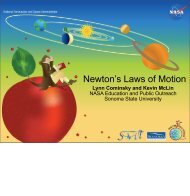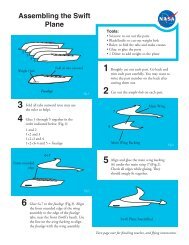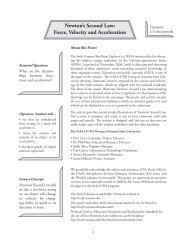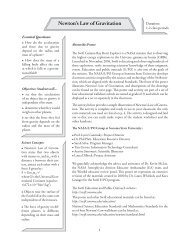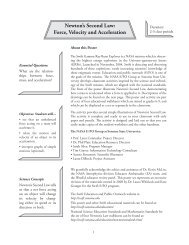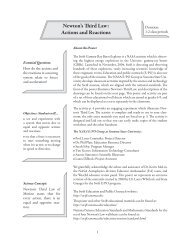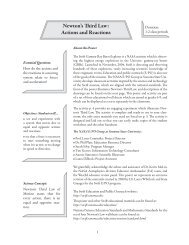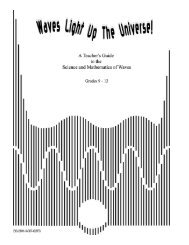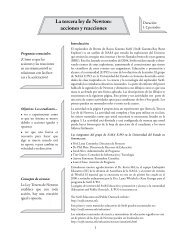Newton's Law of Gravitation - Swift - Sonoma State University
Newton's Law of Gravitation - Swift - Sonoma State University
Newton's Law of Gravitation - Swift - Sonoma State University
Create successful ePaper yourself
Turn your PDF publications into a flip-book with our unique Google optimized e-Paper software.
Part A: The Fall <strong>of</strong> ManYour students will be dropping various objects to the floor to see if theyfall at different rates. Go over the background material to the level youthink is appropriate for your class, but do not go over the concept thatacceleration is independent <strong>of</strong> the mass <strong>of</strong> the falling object! They willfind this out for themselves in the first part <strong>of</strong> the activity. When you givethem materials to test, make sure they have different sizes, masses, anddensities. Make sure they are not breakable! Also, make sure they won’tbe affected too much by air resistance; a balloon or a piece <strong>of</strong> paper won’twork (although crumpled paper will if it is wadded up tightly).After this activity, discuss the results with the students. Most likely, theywill have predicted that the heavier object will hit first and found thatthis is not true; the two objects fell together at the same rate. Explain tothem that this is because the acceleration due to gravity is independent <strong>of</strong>mass. Some students may have a hard time internalizing this. They mayeven disagree with the results. If that happens, demonstrate the activityfor them again from a higher elevation (standing on a chair, for example),using very different mass objects (like a pencil and a heavy weight).Hint:Students may get stuck on Question3, where they try to think<strong>of</strong> things that may have thrown<strong>of</strong>f their timing. The two largestfactors in this are human reactiontime and air resistance. Ifthey get stuck, ask them to dropa pencil and an unfolded sheet <strong>of</strong>paper. Then have them repeat theexperiment, but this time witha pencil and a tightly waddedpiece <strong>of</strong> paper. Ask them whythe wadded paper fell faster, andthey should see that air resistanceslowed the paper the first time.Part B: The Gravity <strong>of</strong> the Situation (Advanced Students)Before doing Part B, remind them <strong>of</strong> the difference between acceleration and force. Go over Newton’ s law <strong>of</strong>gravitation, and stress the idea that the acceleration due to gravity on a planet’s surface depends on the planet’ssize and mass, and that this means that they would have different weights on different planets. Review thederivation <strong>of</strong> “little g” that is given in the background information, and perhaps work one example for a differentplanet, so that they will understand how to proceed. You may also wish to use the questions in the box“Think About It!” as the basis for class discussion after the table is completed.The students might be a little confused over the units for all these numbers (like G = 6.672 x 10 -11 N m 2 /kg 2 ).This is understandable! If they get confused, tell them that to complete the activity they only need to worryabout the values <strong>of</strong> the numbers. The units are important when doing science, but for now they can just usethe numbers.Extension Activity - <strong>Swift</strong> Orbit (Advanced students):The following activity is beyond the normal scope <strong>of</strong> this poster, but may interest advanced students. It mayhelp to let them read the derivation <strong>of</strong> Newton’s <strong>Law</strong> <strong>of</strong> <strong>Gravitation</strong> at:http://swift.sonoma.edu/education/newton/newton_4/gravitation.html. You might have to explain the math tothem first.a) Use Kepler’s <strong>Law</strong>: T 2 = K R 3 to calculate the period <strong>of</strong> the <strong>Swift</strong> satellite in its 600 km orbit around theEarth. The period, T, is how long it takes for <strong>Swift</strong> to orbit once around the Earth. Remember that the distance,R, in this equation is measured from the center <strong>of</strong> the Earth, and that the Earth’s radius is about 6375km. The constant K in this equation is equal to (4π 2 ) / (GM E), where M Eis the mass <strong>of</strong> the Earth, and is equalto 5.96 x 10 24 kg, and G is the gravitational constant: G = 6.67 x 10 -11 N m 2 /kg 2 .b) What is <strong>Swift</strong>’s velocity in its orbit? Recall that v = 2πR/T.c) If <strong>Swift</strong>’s weight in orbit is 1255 kg, (see “Think About It!” part “e” on p. 8) why then do we refer to astronautsorbiting the Earth as “weightless”?5
Answer for Extension Activity:a) K = 9.931 x 10 -14 s 2 m -3R = 6375 + 600 km = 6.975 x 10 6 mTherefore, T = 5805 seconds or 96.7 minutesb) v = 7550 m/secspeed <strong>of</strong> sound)(about 25 times thec) Astronauts are not really weightless in orbit. In fact, they weigh at least 85% <strong>of</strong> their weight on Earth. The effectthat is usually called “weightlessness” is more correctly called “freefall.” The astronauts are falling towards the Earth(moving “vertically”) at the same rate as their space vehicle travels “horizontally,” so they never actually fall to theEarth. You can experience freefall without leaving the Earth – just try jumping <strong>of</strong>f a diving board or into the air. Youwill feel “weightless” until you hit the surface <strong>of</strong> the pool or the ground.Assessment:Points Part A: The Fall <strong>of</strong> Man Part B: Gravity <strong>of</strong> the Situation4A) Student is able to predict the motion <strong>of</strong>objects falling to the ground B) Student isable to make repeatable measurements <strong>of</strong> fallingobjects C) Student is able to thoughtfullyconsider the initial predictions and revise them,if incorrect D) Student is able to correctly concludethat mass has no effect on accelerationA) Student is able to correctly calculate the accelerations forall the solar system bodies listed in the table B) Student isable to correctly calculate all the ratios <strong>of</strong> the accelerationswith respect to that <strong>of</strong> Earth C) Student is able to thoughtfullyconsider the results <strong>of</strong> the calculations and providecorrect answers about Mercury, Jupiter and the Moon D)Student is able to correctly describe the difference betweenmass and weight3 Student achieves the first three objectives above. Student achieves the first three objectives above.2 Student achieves the first two objectives above.Student achieves the first two objectives above or at least half<strong>of</strong> the first two objectives and the third objective.1 Student achieves only the first objective above.Student achieves only the first objective above or parts <strong>of</strong> thefirst two objectives0 Student achieves none <strong>of</strong> the objectives above. Student achieves none <strong>of</strong> the objectives above.Answers to In-Class Activity Questions:Part A: The Fall <strong>of</strong> Man1) Most students will predict the heavier object will hit first.2) They should find that the objects hit at the same time.3) This answer will depend on their prediction. Reasons the experiment might be thrown <strong>of</strong>f could be that theydidn’t let go <strong>of</strong> the objects simultaneously, that the person viewing the impact didn’t see it clearly, or that air resistanceslowed one <strong>of</strong> the objects more than the other.4) Many may change their prediction, saying both will hit simultaneously.5) Most people are surprised that objects with very different masses will fall at the same rate.Part B: The Gravity <strong>of</strong> the SituationPlanet Name Mass (kg) Radius (m)Acceleration(m/sec 2 )Acceleration comparedto EarthMercury 3.3 x 10 23 2.4 x 10 6 3.8 0.39Venus 4.9 x 10 24 6.1 x 10 6 8.9 0.90Earth 6.0 x 10 24 6.4 x 10 6 9.8 1.0Moon 7.4 x 10 22 1.7 x 10 6 1.7 0.17Mars 6.4 x 10 23 3.4 x 10 6 3.7 0.38Jupiter 1.9 x 10 27 7.1 x 10 7 23.1 2.4Saturn 5.7 x 10 26 6.0 x 10 7 9 0.92Uranus 8.7 x 10 25 2.6 x 10 7 9 0.91Neptune 1.0 x 10 26 2.5 x 10 7 11 1.1Pluto 1.3 x 10 22 1.2 x 10 6 0.60 0.0626
Name: ________________________Student Handout:Newton’s <strong>Law</strong> <strong>of</strong> <strong>Gravitation</strong>Date: ______________Period: ________You already know about gravity: it holds you down to the Earth. But there is more to gravitythan that! In this activity you will investigate a few properties <strong>of</strong> gravity and see how itaffects you – not just on Earth, but on other planets!The goal <strong>of</strong> Part A is to determine the relationship between the acceleration due to gravityand the mass <strong>of</strong> an object. The goals <strong>of</strong> Part B are to determine how much you would weighon other planets and how that weight is affected by the mass and radius <strong>of</strong> the planet.Part A: The Fall <strong>of</strong> Man1) Your teacher has supplied you with a collection<strong>of</strong> different objects. Look over them:are they all the same size, the same weight?Pick two <strong>of</strong> the objects that have differentweights and sizes. They should be differentenough that you can easily feel the difference.If they are dropped from the sameheight, will one hit the floor first, or willthey hit at the same time? Make a predictionabout this, and record it.2) Now take the objects and hold them infront <strong>of</strong> you. Make sure the bottoms <strong>of</strong> theobjects are the same height from the floor.Have another student kneel or lie down onthe floor in front <strong>of</strong> you so they have a goodview <strong>of</strong> where the objects will land.Count backwards from three, and on“zero” drop the objects at the same time.Did one hit first? If so, which one? Notewhat happened on your worksheet. Repeatthe procedure at least twice more to makesure you get consistent results.3) Was your prediction accurate? Why orwhy not? Can you think <strong>of</strong> any ways yourexperiment might have been thrown <strong>of</strong>f?Explain.4) Now find two objects that are roughlythe same size, but very different weights.Repeat the experiment, and again recordyour prediction and the results5) Did the results surprise you? Why orwhy not?Part B: The Gravity <strong>of</strong> the Situation (Advanced students):Newton’s model <strong>of</strong> gravity is one <strong>of</strong> the most important scientific models in history. It appliesto apples falling from trees, baseballs soaring into the outfield, and milk being spilled in yourschool cafeteria. The exact same model applies to other planets in our Solar System, too!Use the Solar System table given below to determine the value <strong>of</strong> g, the acceleration dueto gravity, for each <strong>of</strong> the other planets in the SolarSystem. Use the equation for acceleration in the boxand the values for the masses and radii <strong>of</strong> the planetslisted in the table. Complete the third column <strong>of</strong> thetable with the value for the surface gravitational accelerationfor each planet (and the Moon).g = GM/R 2where M = mass, R = radius,and G = 6.672 x 10 -11 N m 2 /kg 27
Part A: The Fall <strong>of</strong> Man - Answer the following(use a separate sheet <strong>of</strong> paper if necessary):1. My predictions:4. Observations <strong>of</strong> second experiment:2. This is what I observed:5. Were you surprised? Why or why not?3. Accurate predictions?Part B: The Gravity <strong>of</strong> the Situation - Complete the solar system data chart:Planet Name Mass (kg) Radius (m)Mercury 3.3 x 10 23 2.4 x 10 6Venus 4.9 x 10 24 6.1 x 10 6Acceleration(m/sec 2 )Acceleration comparedto EarthEarth 6.0 x 10 24 6.4 x 10 6 9.8 m/sec 2 1Moon 7.4 x 10 22 1.7 x 10 6Mars 6.4 x 10 23 3.4 x 10 6Jupiter 1.9 x 10 27 7.1 x 10 7Saturn 5.7 x 10 26 6.0 x 10 7Uranus 8.7 x 10 25 2.6 x 10 7Neptune 1.0 x 10 26 2.5 x 10 7Pluto 1.3 x 10 22 1.2 x 10 6Once you complete the third column, you can see how strong(or weak) gravity is on other planets. A better way to understandthis is to compare the gravity <strong>of</strong> the planets with theEarth’s. So in the last column, divide the gravity you got forthe other planets by the Earth’s gravity (for example, afteryou do this, you will get the Earth’s gravity = 1, since you aredividing the number you got for Earth’s gravity by itself).8Think about it!a. Would you weigh more or less onMercury than you do on Earth?b. How about Jupiter?c. How much would you weigh on the Moon?d.What is the difference between mass and weight?e. If <strong>Swift</strong> weighs 1500 kilograms on the surface<strong>of</strong> the Earth, how much does it weigh at anorbit <strong>of</strong> 600 km above the Earth’s surface?
Answers to Think About It!a) You would weigh less on Mercury than on the Earth. (The “g” factor is 0.39 times that <strong>of</strong> Earth.)b) You would weigh more on Jupiter than on the Earth. (The “g” factor is 2.4 times that <strong>of</strong> Earth.)c) On the Moon, you would weigh 0.17 times your weight on Earth, or about 1/6 as much.d) Mass is the amount <strong>of</strong> “stuff” in an object, and weight is the result <strong>of</strong> the force <strong>of</strong> gravity acting on thatamount <strong>of</strong> stuff. When you go to a different planet, you look the same (mass) but your weight will change,depending on the changes in the gravitational force.e) The value <strong>of</strong> “g” in <strong>Swift</strong>’s orbit is 8.2 m/sec 2 compared to 9.8 m/sec 2 on the surface <strong>of</strong> the Earth. <strong>Swift</strong>would therefore weigh 1500 kg x (8.2/9.8) = 1255 kg in orbit.References for all Four Posters:Copies <strong>of</strong> these materials, along with additional information on Newton’s <strong>Law</strong>s <strong>of</strong> Motion and <strong>Law</strong> <strong>of</strong><strong>Gravitation</strong>, are available on the <strong>Swift</strong> Mission Education and Public Outreach Web site:http://swift.sonoma.edu/• NASA Web sites:NASA’s <strong>of</strong>ficial Web site - http://www.nasa.gov<strong>Swift</strong> Satellite - http://swift.gsfc.nasa.gov• NASA Education Resources:Imagine the Universe! - http://imagine.gsfc.nasa.govThe Space Place - http://spaceplace.nasa.govImagine the Universe! - http://imagine.gsfc.nasa.gov• NASA’s Central Operation <strong>of</strong> Resources for Educators (CORE):http://education.nasa.gov/edprograms/core/home/index.htmlCheck out these videos:“Lift<strong>of</strong>f to Learning: Newton in Space” (1992), $15.00“Flight Testing Newton’s <strong>Law</strong>s” (1999), $24.00• NASA’s Space Science Education Resource Directory:http://teachspacescience.org• Newton’s <strong>Law</strong>s <strong>of</strong> Motion:http://www-istp.gsfc.nasa.gov/stargaze/Snewton.htmhttp://www.grc.nasa.gov/WWW/K-12/airplane/newton.html• Newton’s <strong>Law</strong> <strong>of</strong> <strong>Gravitation</strong>:http://csep10.phys.utk.edu/astr161/lect/history/newtongrav.html• Newton in the Classroom:http://www.physicsclassroom.com/Class/newtlaws/newtltoc.htmlhttp://www.glenbrook.k12.il.us/gbssci/phys/Class/newtlaws/u2l1a.html• The Nine Planets:http://seds.lpl.arizona.edu/nineplanets/nineplanets/nineplanets.htmlhttp://seds.lpl.arizona.edu/nineplanets/nineplanets/data1.htmlhttp://swift.sonoma.edu9



